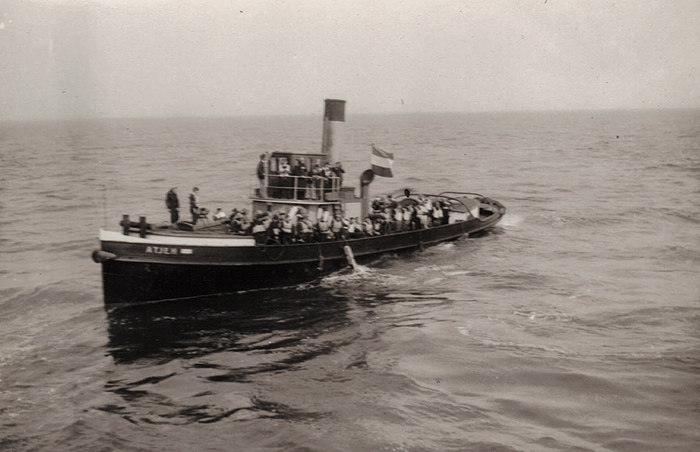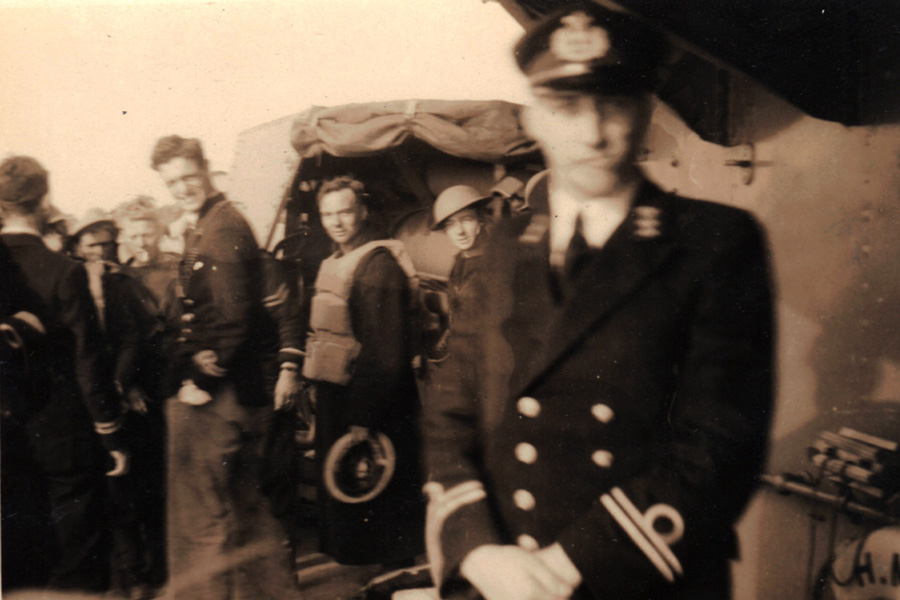








The Zeemanshoop (left) and Atjeh (right) photographed by Lt Peter Kershaw RNVR on the 15 May 1940
Courtesy of Richard Kershaw
The Kent Fortress Royal Engineers (KFRE) and the XD Operations
In 1932 the decision was taken to replace regular gunner and sapper units manning
coastal defences with Territorial units. Gravesend in north west Kent
was the centre of the British cement industry and the Blue Circle
Cement Co was the largest employer. Clifford Brazier, the manager of
their biggest cement works, had served as a sapper officer in World War
I and was asked to raise and command a unit which was initially
almost exclusively drawn from Blue Circle employees and was named the Kent
Fortress Royal Engineers (KFRE).
The
KFRE was given the job of manning Grain Fort, the HQ of the Thames and
Medway defences, but early in 1940 during the nine months phoney war Lt
Col. Brazier received orders direct from the Military Operations Branch
of the War Office to prepare for XD Operations, the hugely challenging
job of destroying fuel reserves in Holland
and north France before they fell into German hands. On Friday 10 May, the day German forces invaded the Netherlands, three small units left for Dover and embarked on the waiting destroyers. Wild Swan was to go to the Hook of Holland to destroy fuel stores at Rotterdam, HMS Verity to Flushing and HMS Brilliant would try and reach Antwerp via the Scheldt.
HMS Whitshed was given the job of taking Cdr Goodenough's naval demolition team of eighty plus a sixteen strong Royal Enginers "demo team" from the KFRE led by Capt Peter Keeble to Ijmuiden. HMS Whitshed (Cdr E.R. Condor RN) left Dover at 1200 and from 1500 was repeatedly attacked by German aircraft during the crossing to Ijmuiden and five of the crew were lost overboard (one recovered later). On arrival the demo team went by a specially laid on single carriage train to Amsterdam and after delicate negotiations with the Dutch were given the go ahead to destroy the fuel reserves on 13 May. Dutch accounts suggest they only partially succeeded (plastic explosives, magnesium incendiary devices and delay fuses were not available). They returned to Ijmeiden on a commandeered lorry and split into two groups to assist the navy in destroying the port instalations on either side of the harbour. There were no waiting destroyers to take them home.
Cdr Goodenough remained at Ijmuiden throughout and a PDF of his lengthy report dated 17 May in Operations off Dutch, Belgian and French coasts: reports, 1940 (NA ADM 199/795) at the National Archives describes the mining of the port by German aircraft on 11 May, the bombing of the harbour on 12 May followed by plans to evacuate refugees aboard SS Botterel, the arrival of HMS Codrington and four destroyers at 2100 to evacuate the Dutch Royal Family (Goodenough was not notified of this) and the departure of SS Perseus, the third of three merchant ships carrying the country's gold reserves (the first two left on 11 May). At 0700 on Tuesday 14 May HMS Vesper arrived with signals for the immediate destruction of the oil reserves at Amsterdam. The remainder of Goodenough's report describes the blocking of the harbour. Goodenough and his party left on a "harbour launch" (not named in his report) and had fuel for 20 miles and no food when thery encountered Venomous.
Peter Keeble's second in command, Lt Don Terry, joined Cdr Goodenough on the Dutch harbour tug, Atjeh (named after a province in the Dutch East Indies) which was helping
the auxiliary mine sweeper M3 tow the SS Jan Pieterszoon Coen
into position to block the harbour entrance. A German sircraft
dropped two magnetic mines but they successfully blocked both harbour
entrances by sinking the SS Jan Pieterszoon Coen and the minesweeper. Willem Soolsma, the mate of the Atjeh, interviewed on Dutch Radio in 1989
described how a boat came alongside with fifty or sixty men aboard
including Cdr Helingman, the naval commander of Ijmuiden, and a Jewish
man who desperate to escape had jumped into the water from the dyke.
They transferred to the Atjeh
and on the afternoon of the 14 May left Ijmuiden heading west for
the first hour to clear the coast and then changing course to the south
west for England. The Atjeh was a harbor tug, not
sea-going and it had over seventy on board but was designed for no more than twenty five passengers plus the crew of three (the skipper, C.J. Straatman, the Mate W. Soolsma and the engineer P. Tienstra). They had almost ran out of coal and the crew were beginning to heat the boilers with wooden panels when they were spotted by Venomous, taken aboard and photographed in jublilant mood by Lt Peter Kershaw RNVR.
Captain Keeble's group left Ijmuiden after dark on a thirty foot motor launch and were picked up by HMS Havoc and landed at Harwich.


Cdr Goodenough and Capt Peter Keeble were both awarded the DSO. In his letter congratulating Keeble Goodenough said "after working in the Plans Division in the Admiralty the Amsterdam party was just like a paid holiday!" The Atjeh served in UK harbours throughout the war, at first in Portsmouth, later Greenock, and after the war returned to Amsterdam.
When Don Terry drove to the site of the refinery at Amsterdam in 1945 he met a group of middle aged women who remembered the firing of the oil stocks and admonished him for not having warned them so that they could get their washing in which was ruined as a result! Monday was the traditional washing day in the Netherlands and Monday 13 May was the day when the "demo team" set fire to the oil storage tanks at Amsterdam.
On
demobilisation most of the original members of the Kent Fortress Royal
Engineers returned to their jobs with Blue Circle, several of the
junior officers were made works managers and Peter Keeble became a
director.

Most of what is known about the tug, Atjeh, is from the English language Forum on the "War over Holland" website created by Allert M.A. Goossens, a Dutch war historian, and the men on Venomous whose accounts can be seen in A Hard Fought Ship. I would also like to acknowledge the assistance of Jan Visser who supplied details from the three volume History of the Dutch Merchant Navy by K.W.L. Bezemer (Elsevier, 1987) and De Nederland in de Tweede Wereldoorlog by J.W. de Roever (1951). His web site on the Royal Netherlands Navy Warships of World War II is a valuable resource for researchers.
An overview of operations by British forces during the invasion of Holland in May 1940 including the role of the "demo" teams can be seen on the War over Holland website. The book XD Operations - Secret British missions denying oil to the Nazi's by C.C.H. Brazier (Pen and Sword, 2005) is written by its former commander and edited by his son.